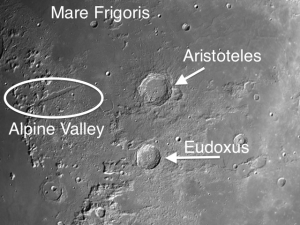The week of August 22nd – August 28th takes us from Day 20 to Day 26. The Moon rises at about 10:40 PM local time on Monday, but not until 2:40 AM on Sunday. This week we will feature the crater Aristoteles.
 Aristoteles: [NE/D11] Close to the terminator this evening, there is an eye-catching pair of craters, Aristoteles and Eudoxus. Aristoteles is a complex crater with terraces, but in place of a central mountain it has a couple of small off-center peaks that are poking through the lava plain on its floor. The substantial ejecta blanket to the north of Aristoteles clearly shows radial structure, and if you catch it in the early morning sunrise, it will look like many points of light peeking through the shadows.
Aristoteles: [NE/D11] Close to the terminator this evening, there is an eye-catching pair of craters, Aristoteles and Eudoxus. Aristoteles is a complex crater with terraces, but in place of a central mountain it has a couple of small off-center peaks that are poking through the lava plain on its floor. The substantial ejecta blanket to the north of Aristoteles clearly shows radial structure, and if you catch it in the early morning sunrise, it will look like many points of light peeking through the shadows.
Aristoteles adjoins the crater Mitchell to its immediate east. The pair violates the standard rule that smaller, younger craters are superimposed on top of larger, older craters. Can you tell that the younger (and larger) Aristoteles is intruding onto Mitchell (which is older and smaller)?
And check out the Alpine Valley immediately to the west of Aristoteles. See if you spot the tiny rille meandering down its middle. The rille is visible through a 5″ refractor (provided that you have excellent optics and great seeing). An 8-inch telescope will increase your chances considerably.
OF ADDITIONAL INTEREST ON LUNAR DAYS 20-26:
Start observing Jupiter and Venus on Monday as they approach a close conjunction on Saturday. Scan the western horizon after sunset, BUT BE SURE THE SUN HAS COMPLETELY SET! PERMANENT EYE DAMAGE WILL RESULT IF YOU ACCIDENTALLY VIEW THE SUN THROUGH BINOCULARS! On Monday they are 5° apart. On Saturday they will be less than 1/2° apart and you can easily see them in the same field of view with moderate power!
======================
It is highly recommended that you get a copy of Sky and Telescope’s Field Map of the Moon, the very finest Moon map available for use at the telescope. It is available for $10.95 at www.skyandtelescope.com and on Amazon. All features mentioned in this blog will be keyed to the grid on the Field Map and will look like this: Plato: [NW/D9]
Credits:
Courtesy of Gray Photography of Corpus Christi, Texas
Lunar photos: NASA / USGS / BMDO / LROC / ASU / DLR / LOLA / Moon Globe. Used by permission
- Rupes Cauchy: A Best Known Fault on the Moon - July 22, 2024
- Moon Crater Schickard – Crater Floor has Stripes - July 15, 2024
- Moon Craters Langrenus and Vandelinus - July 8, 2024